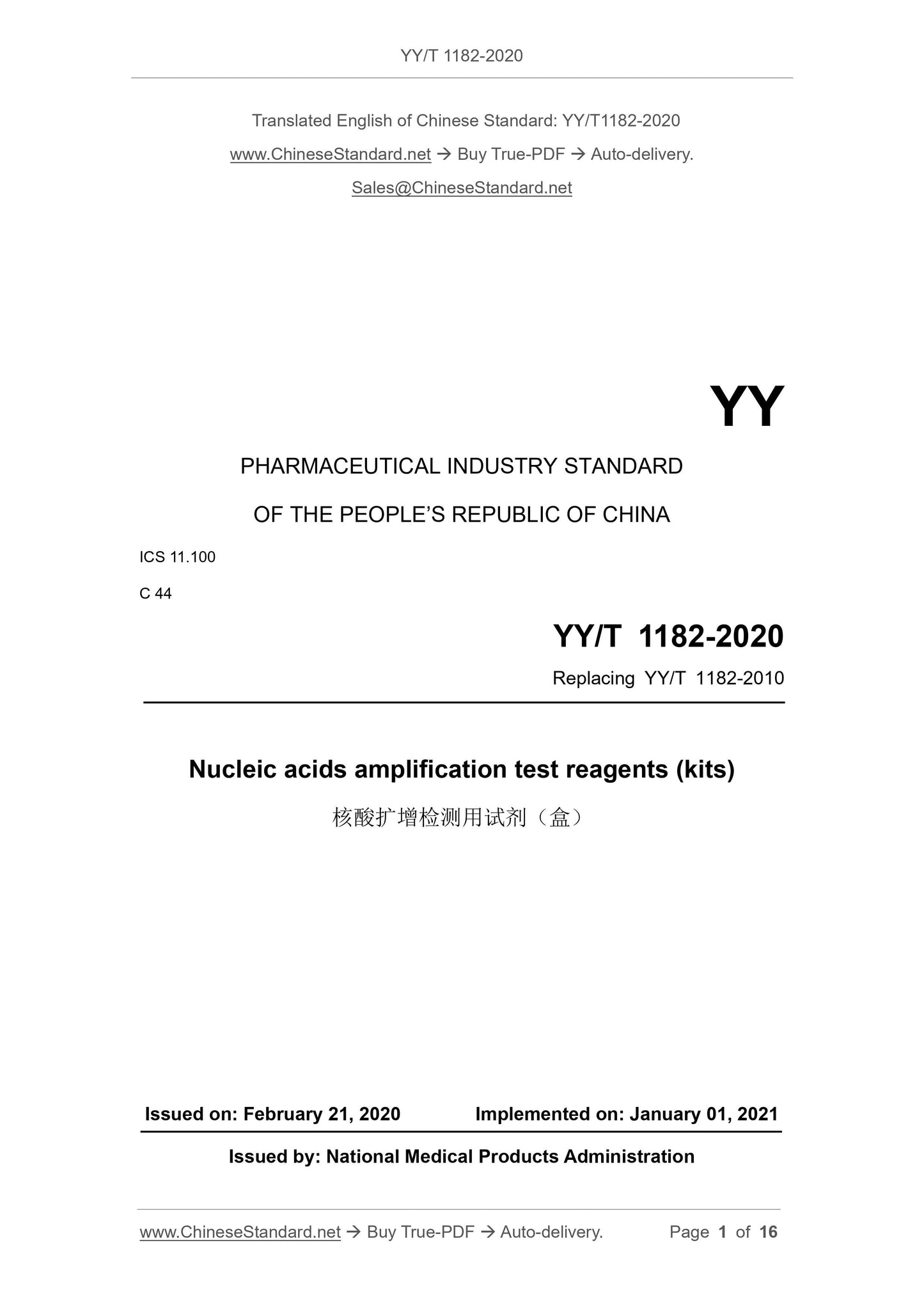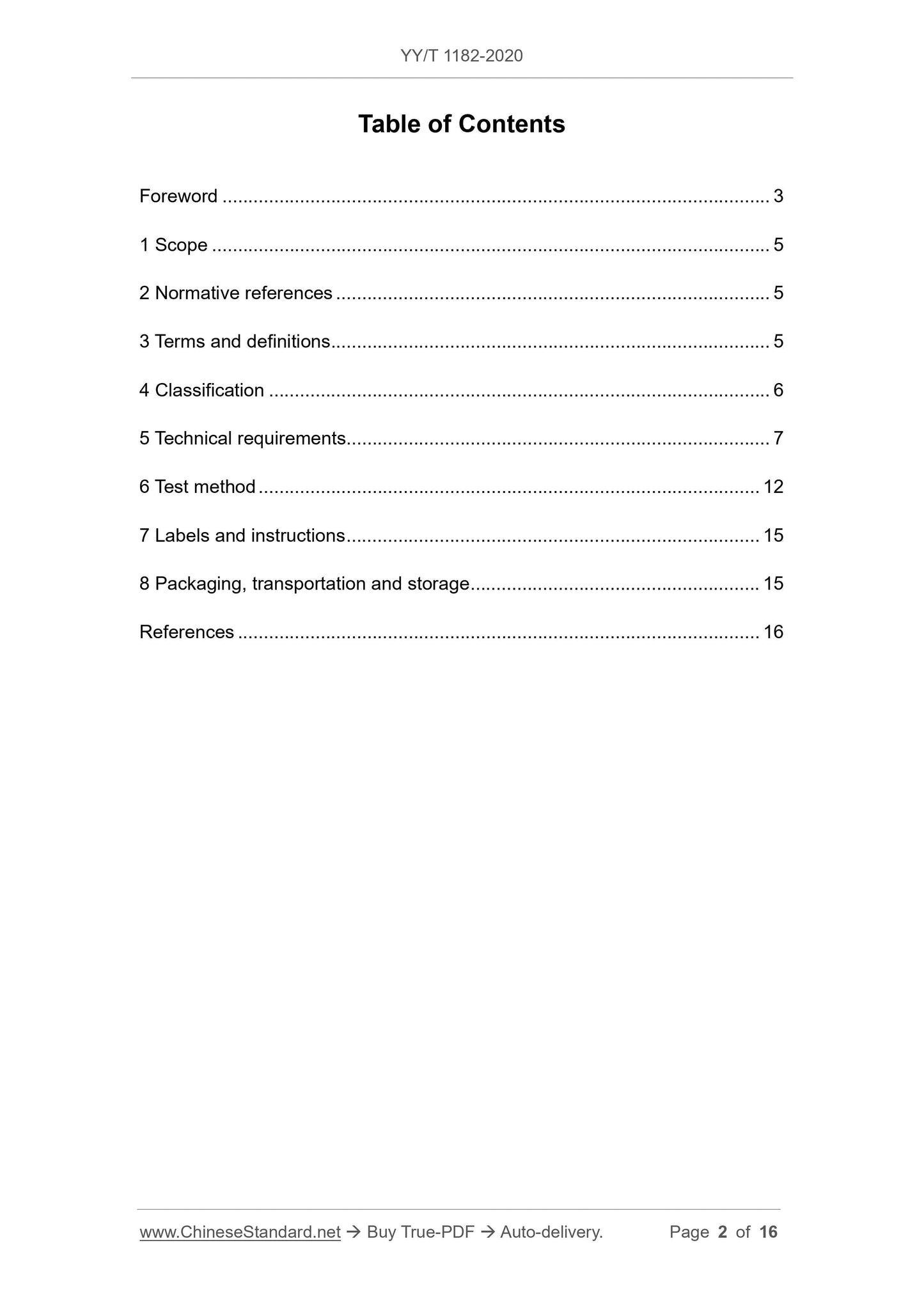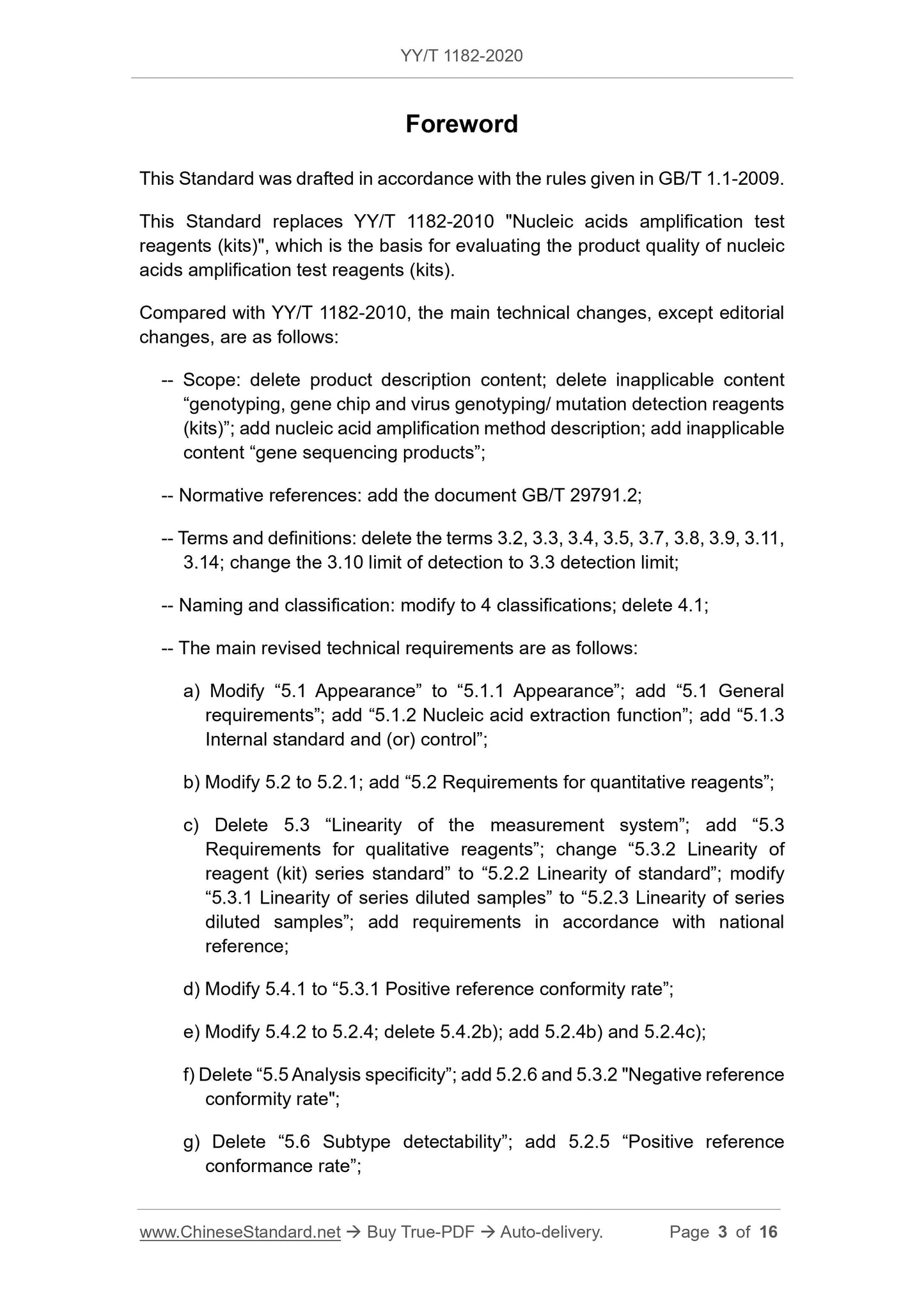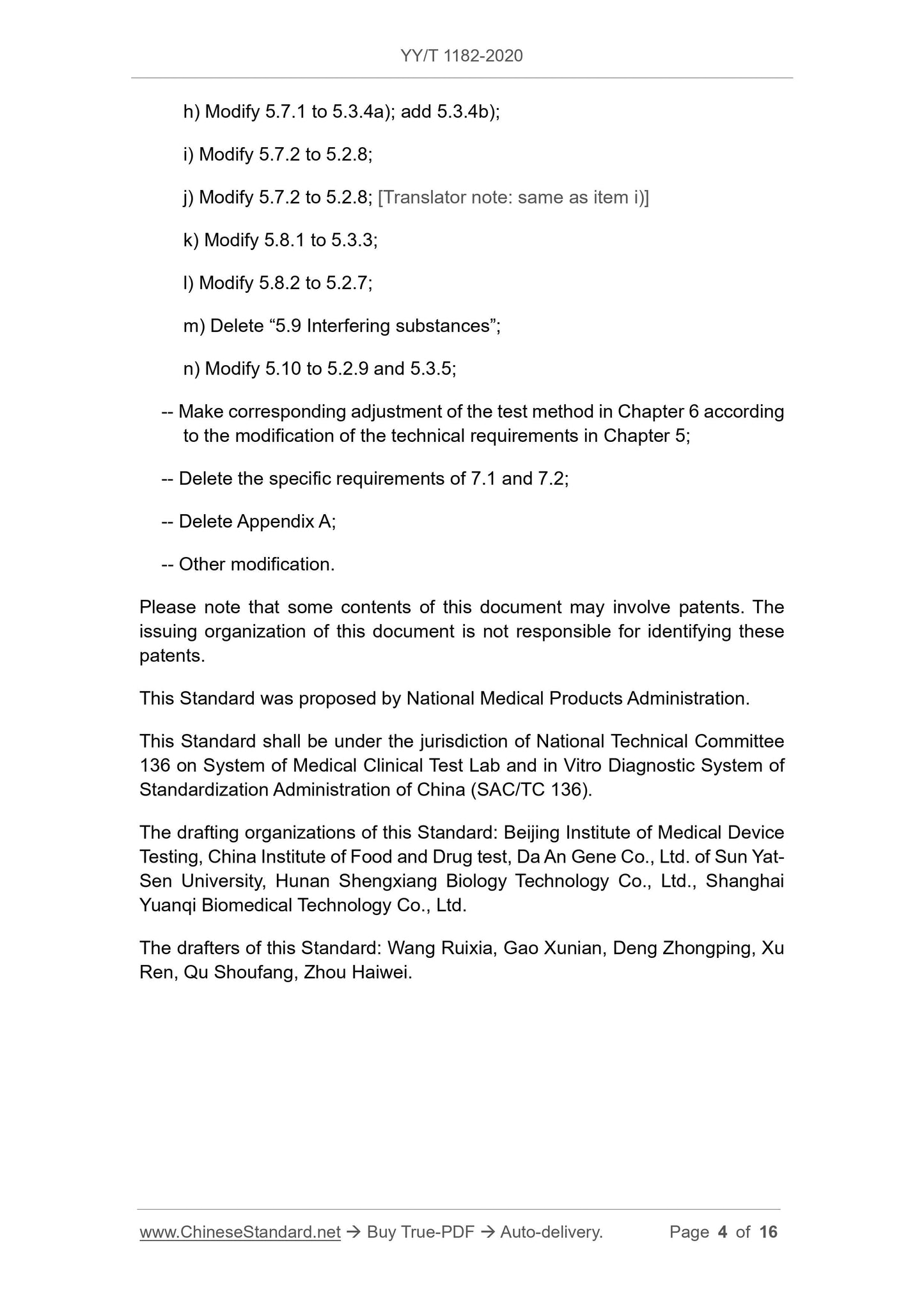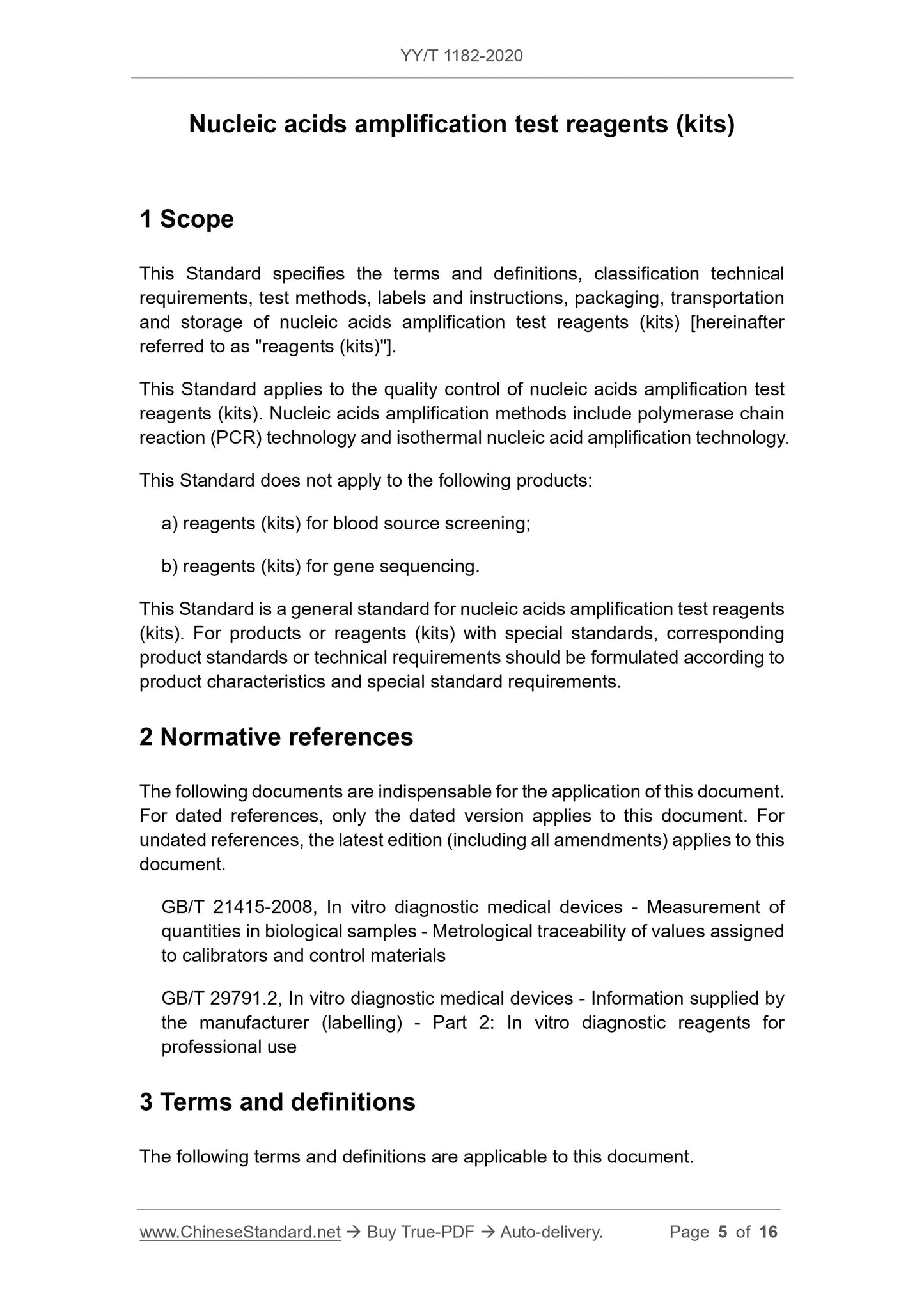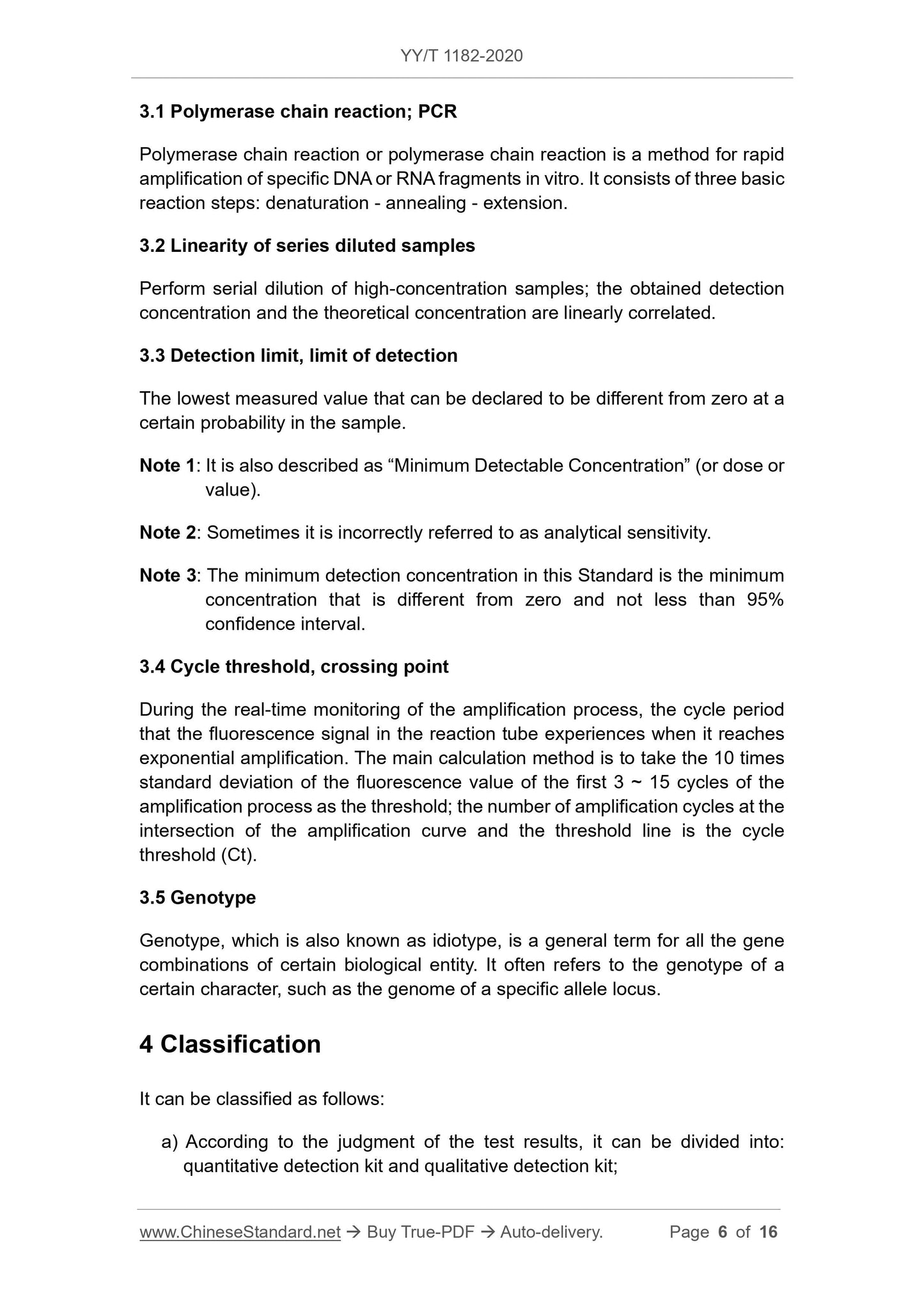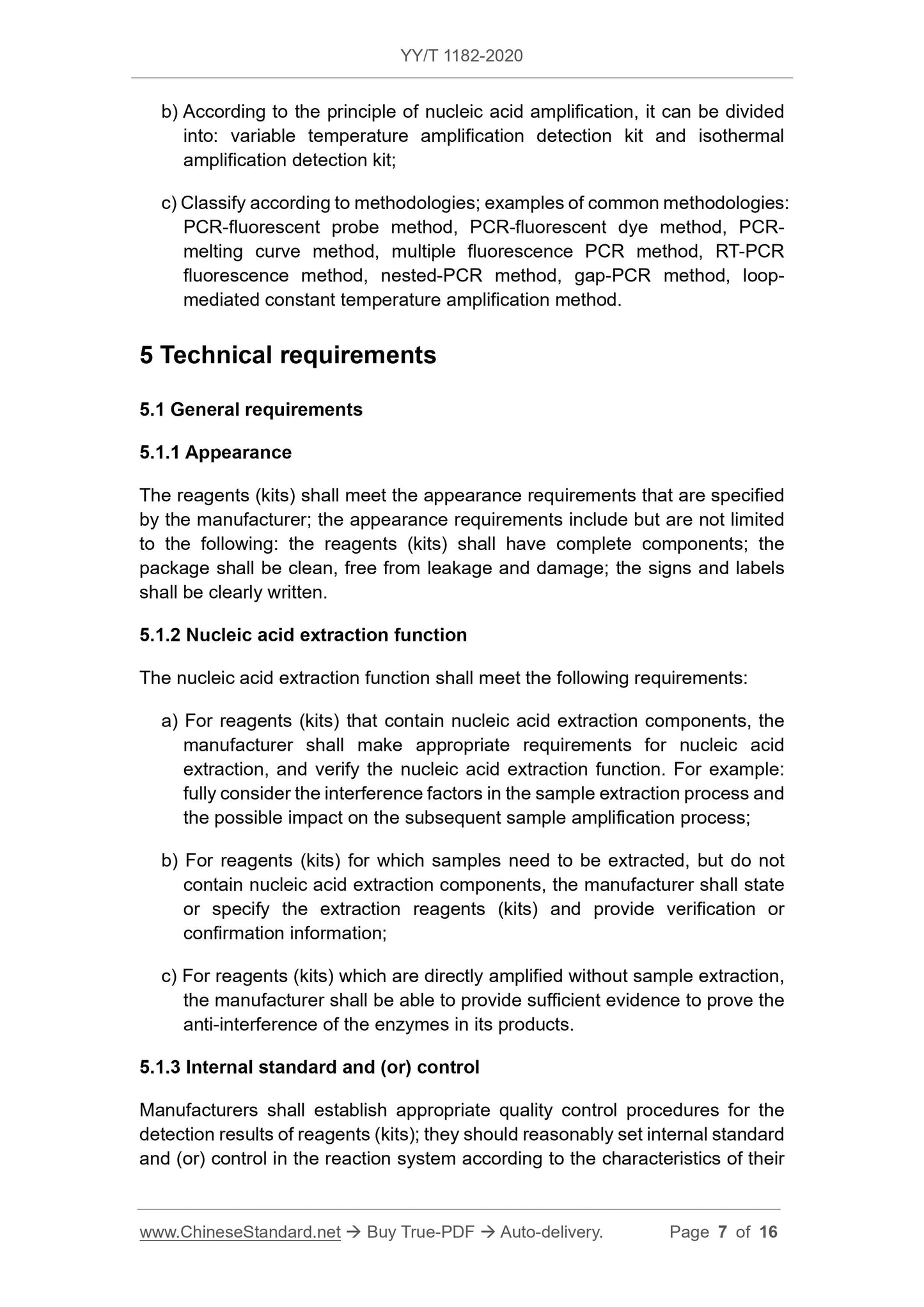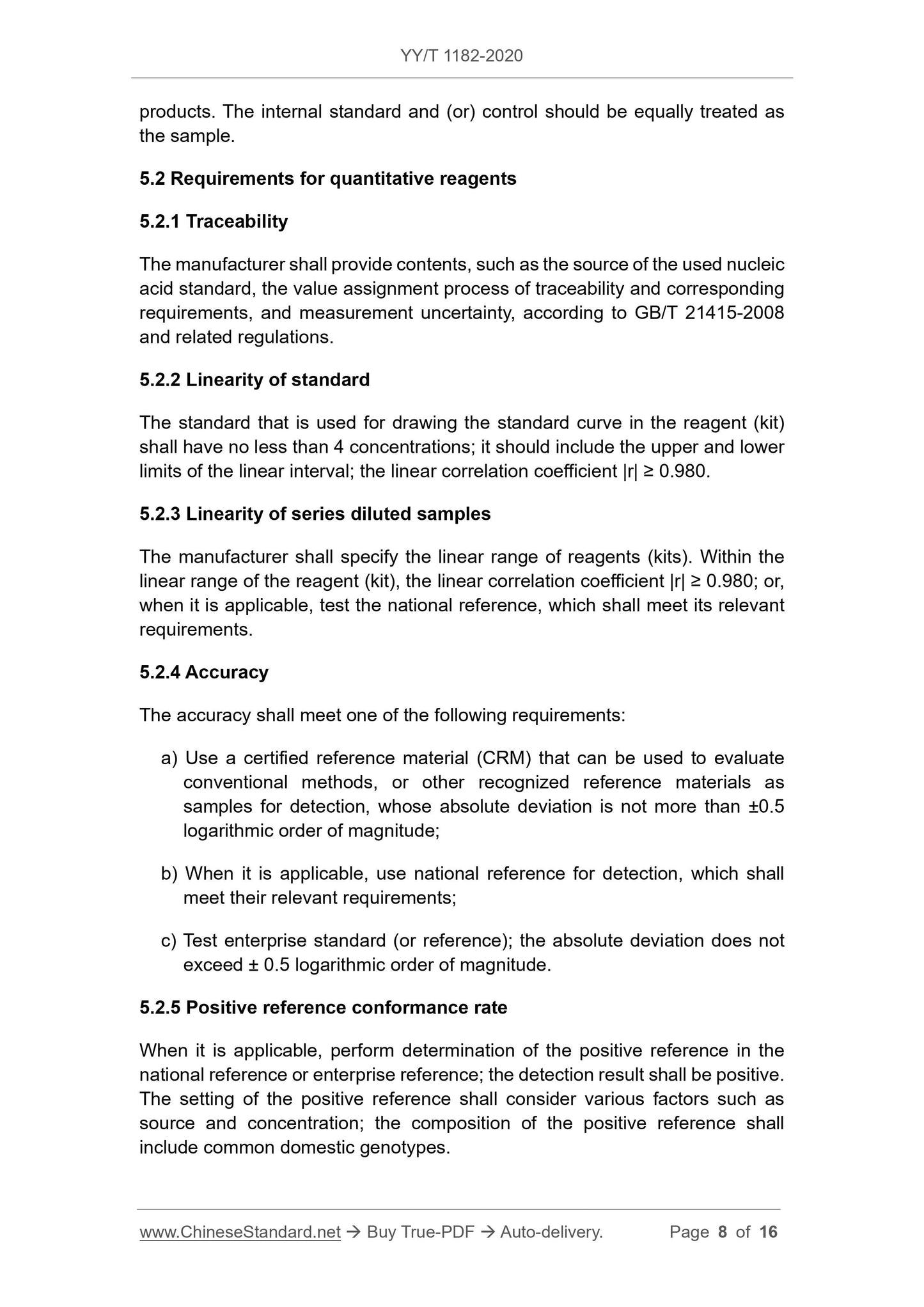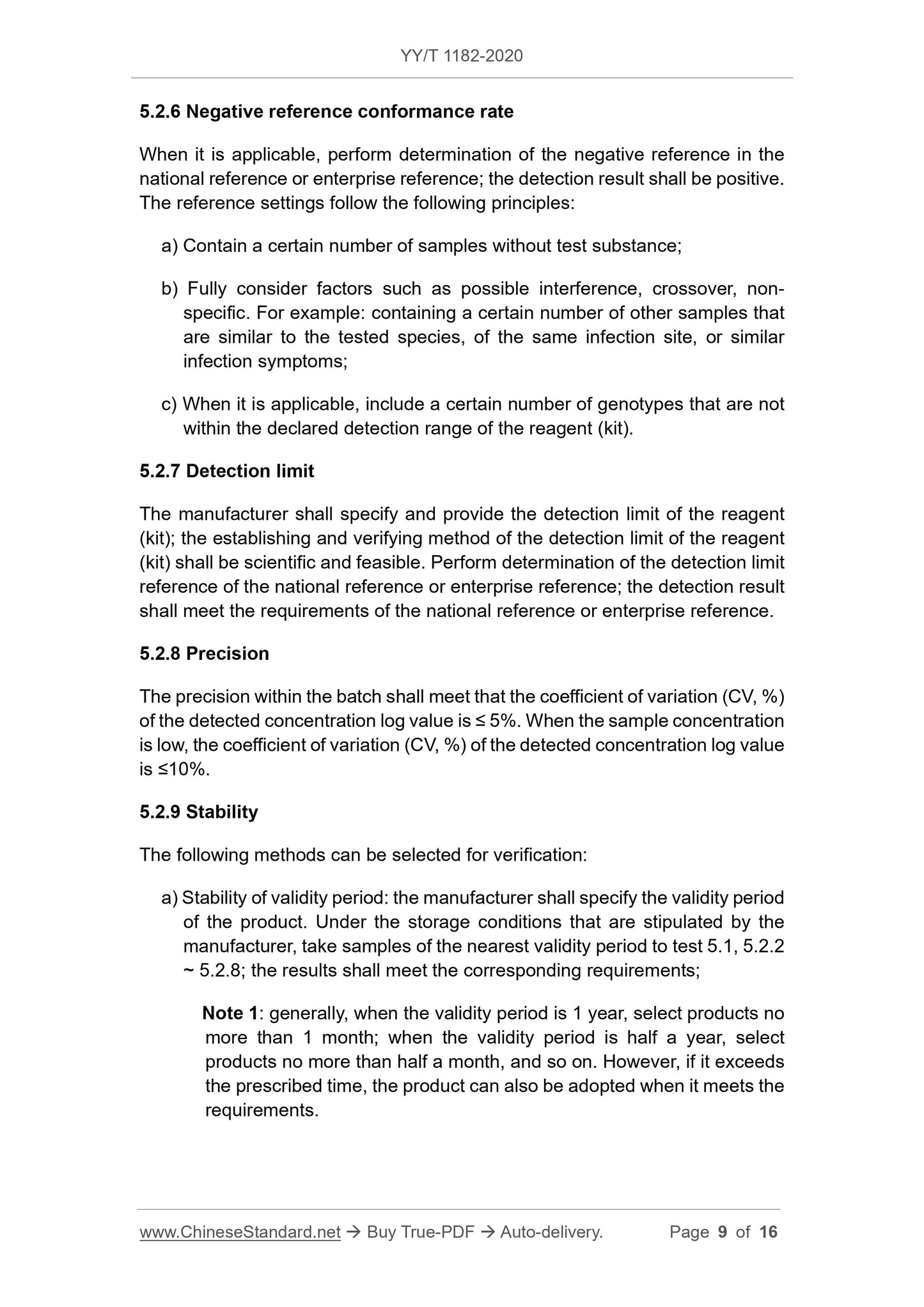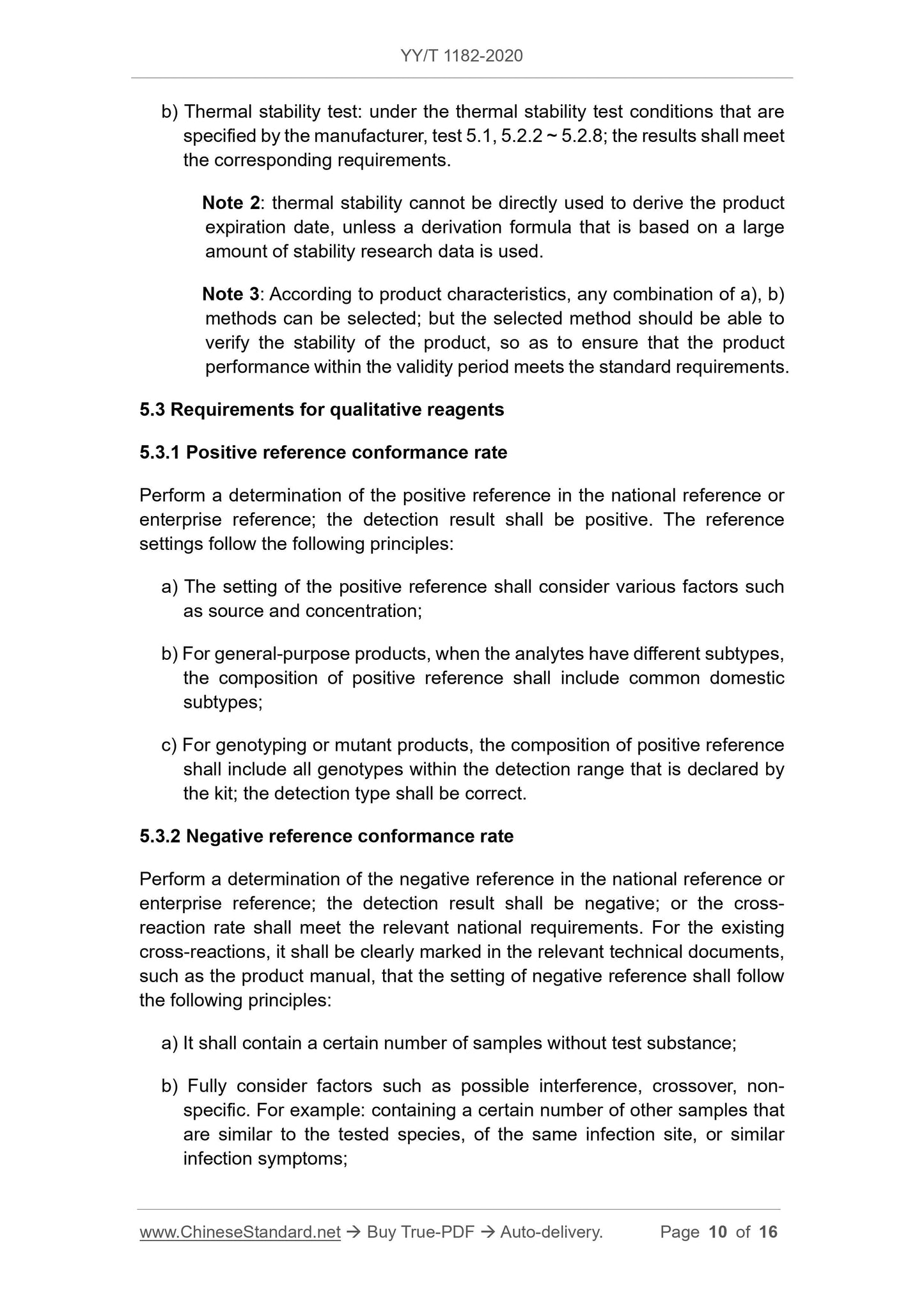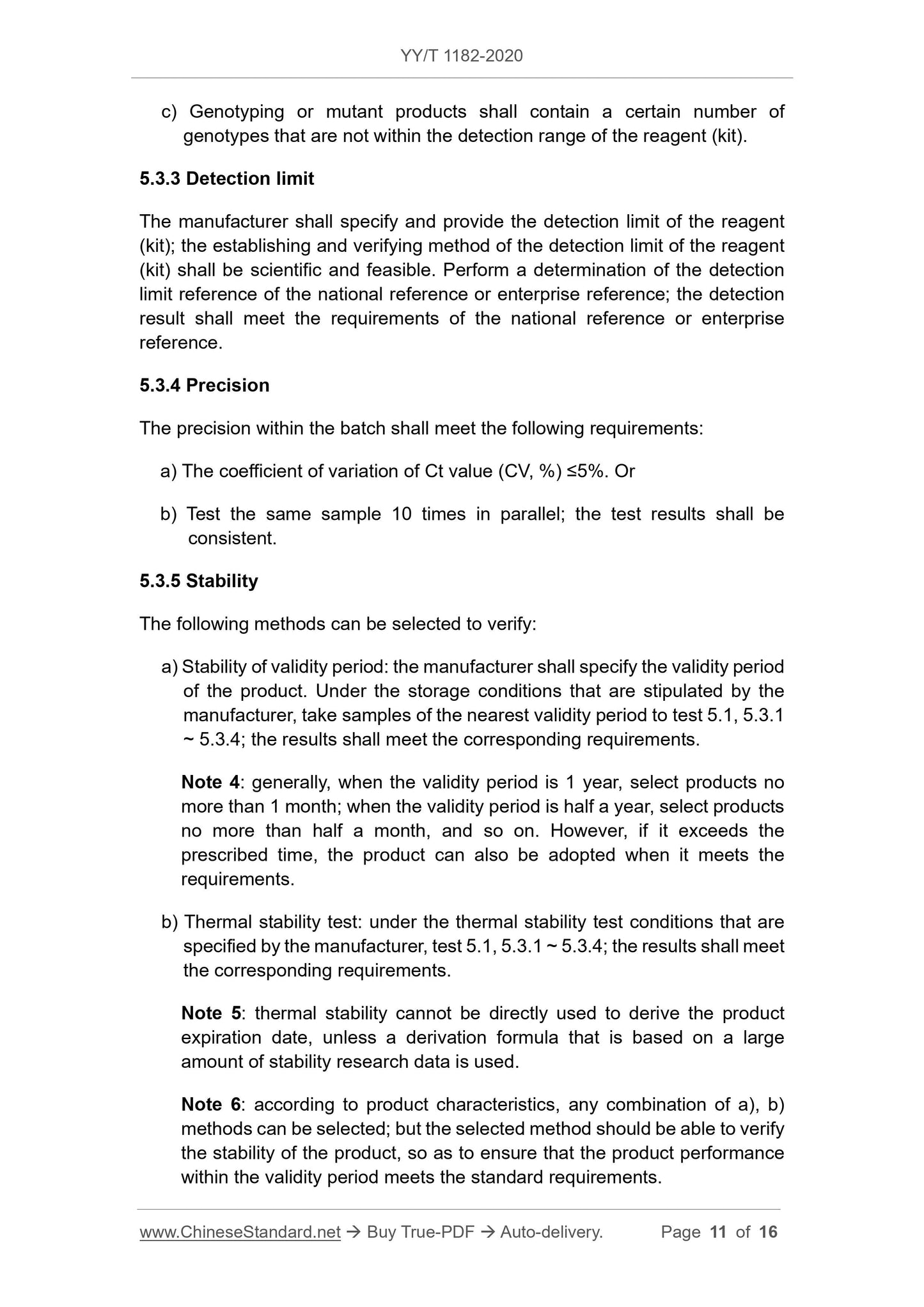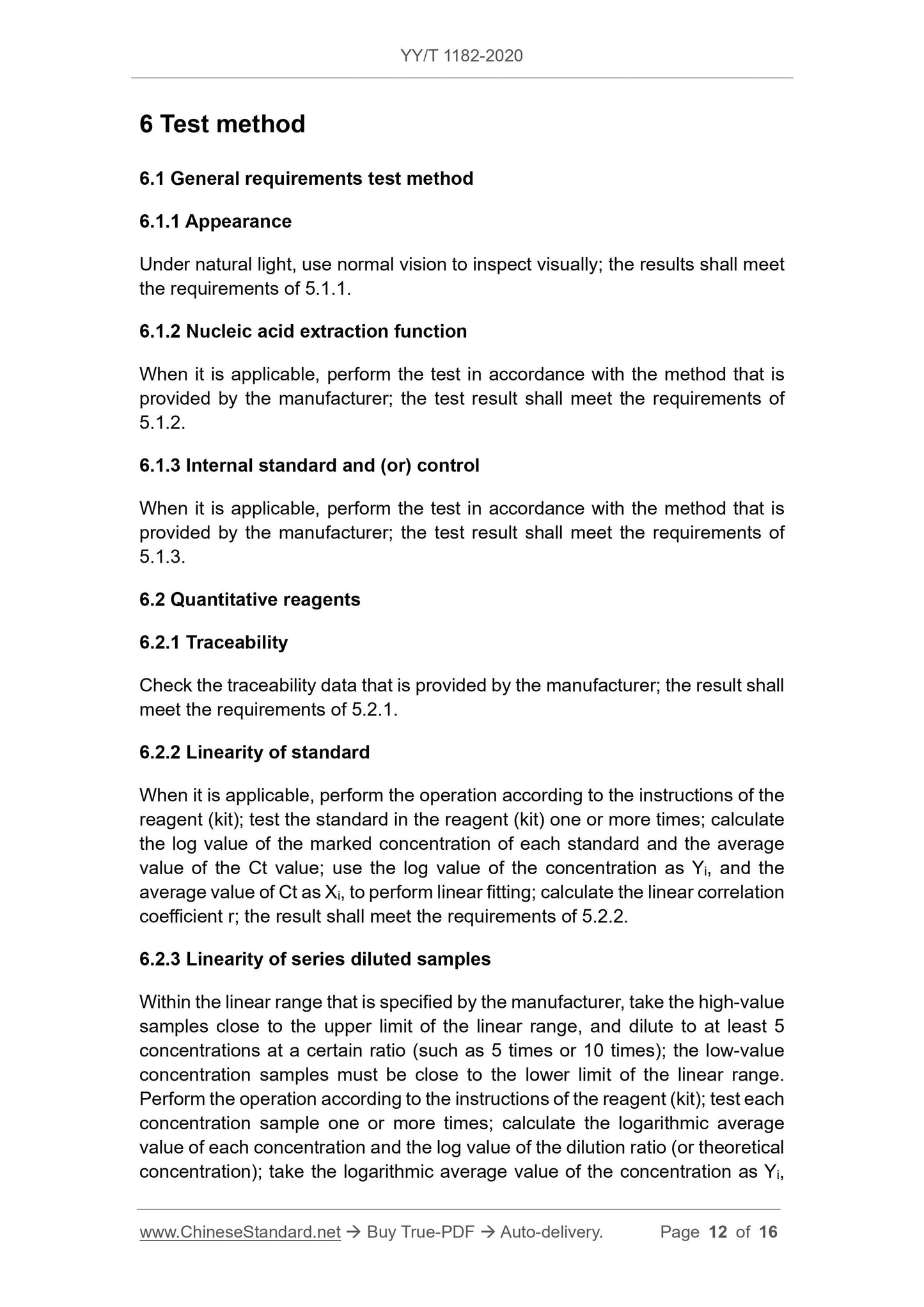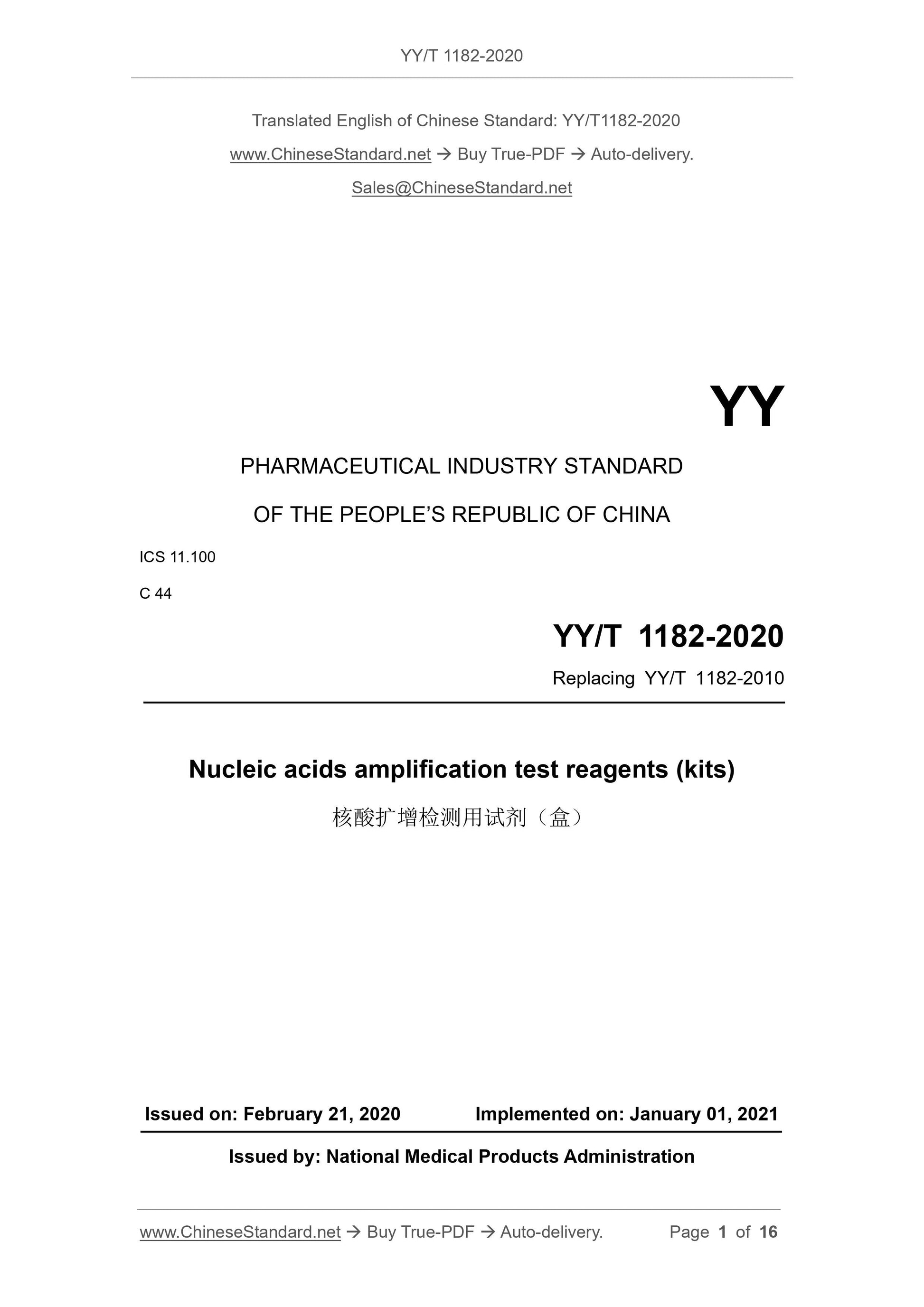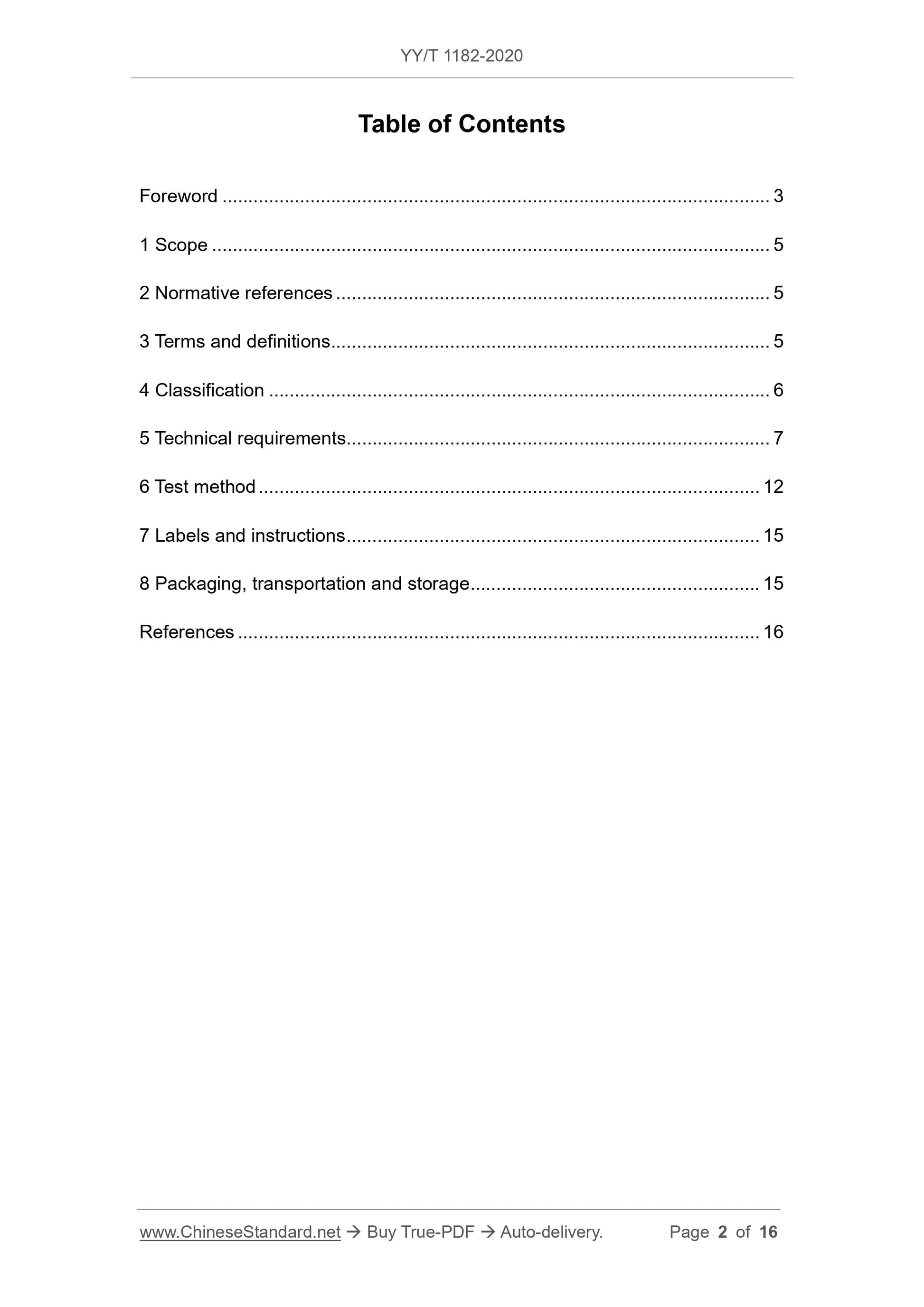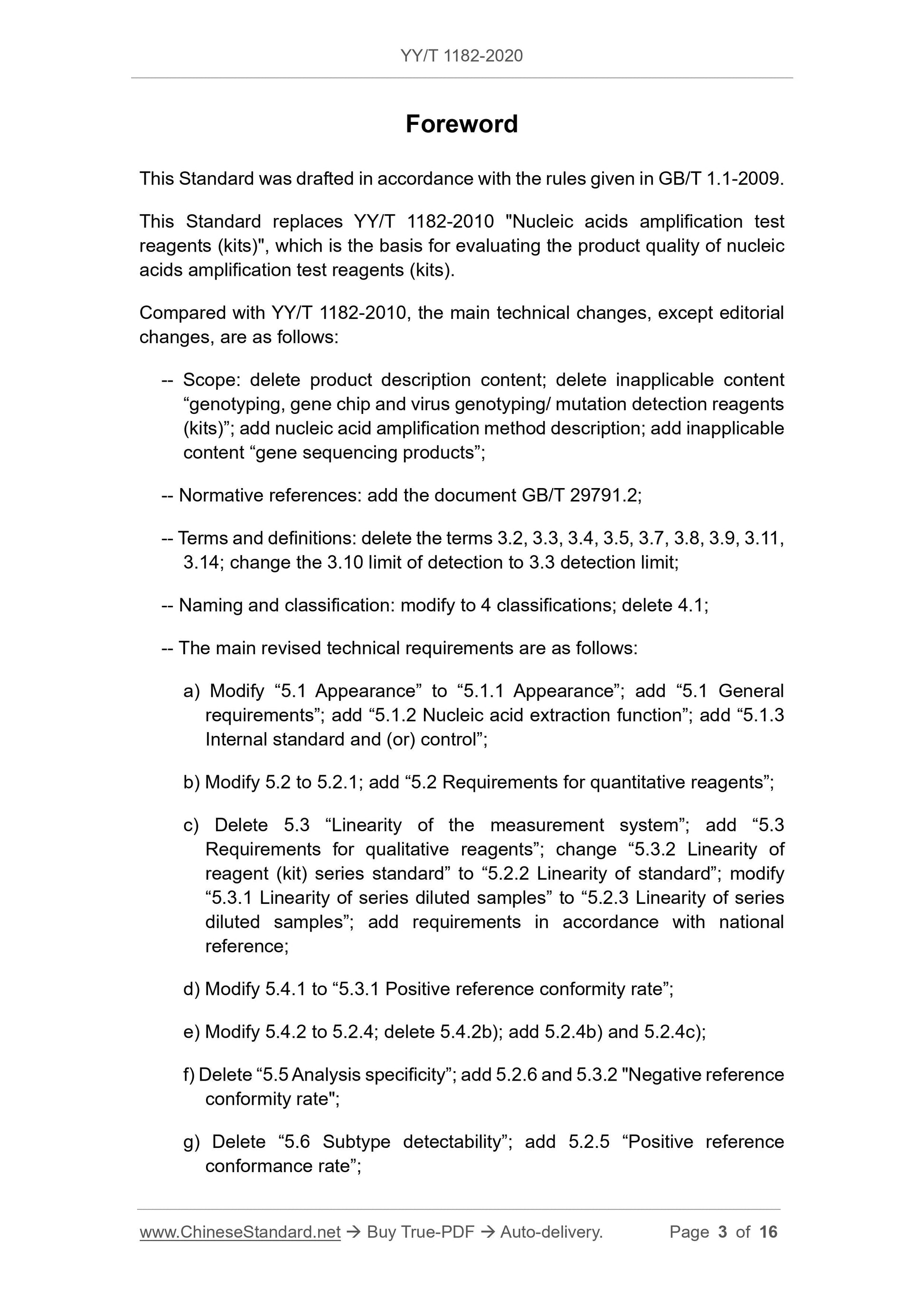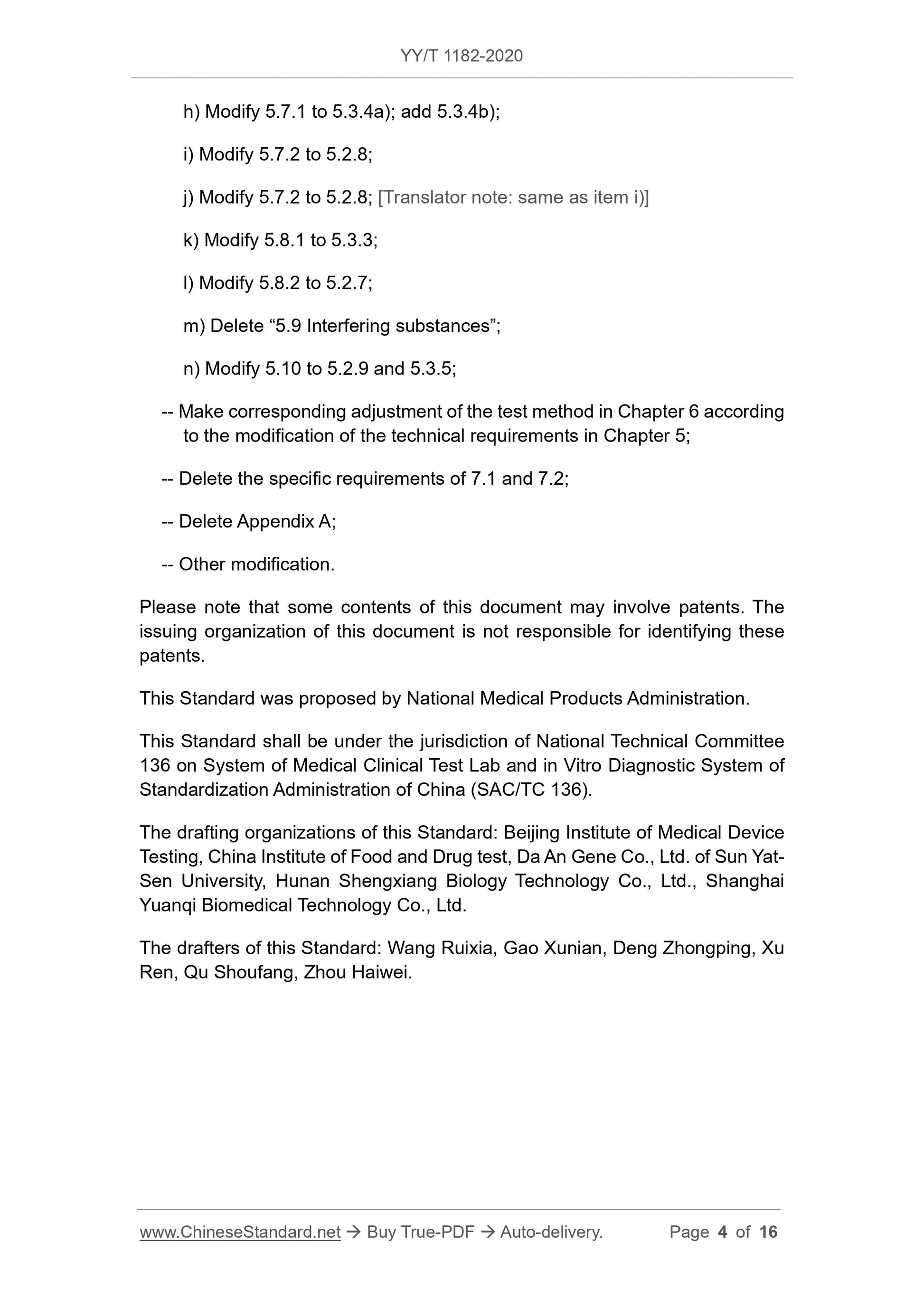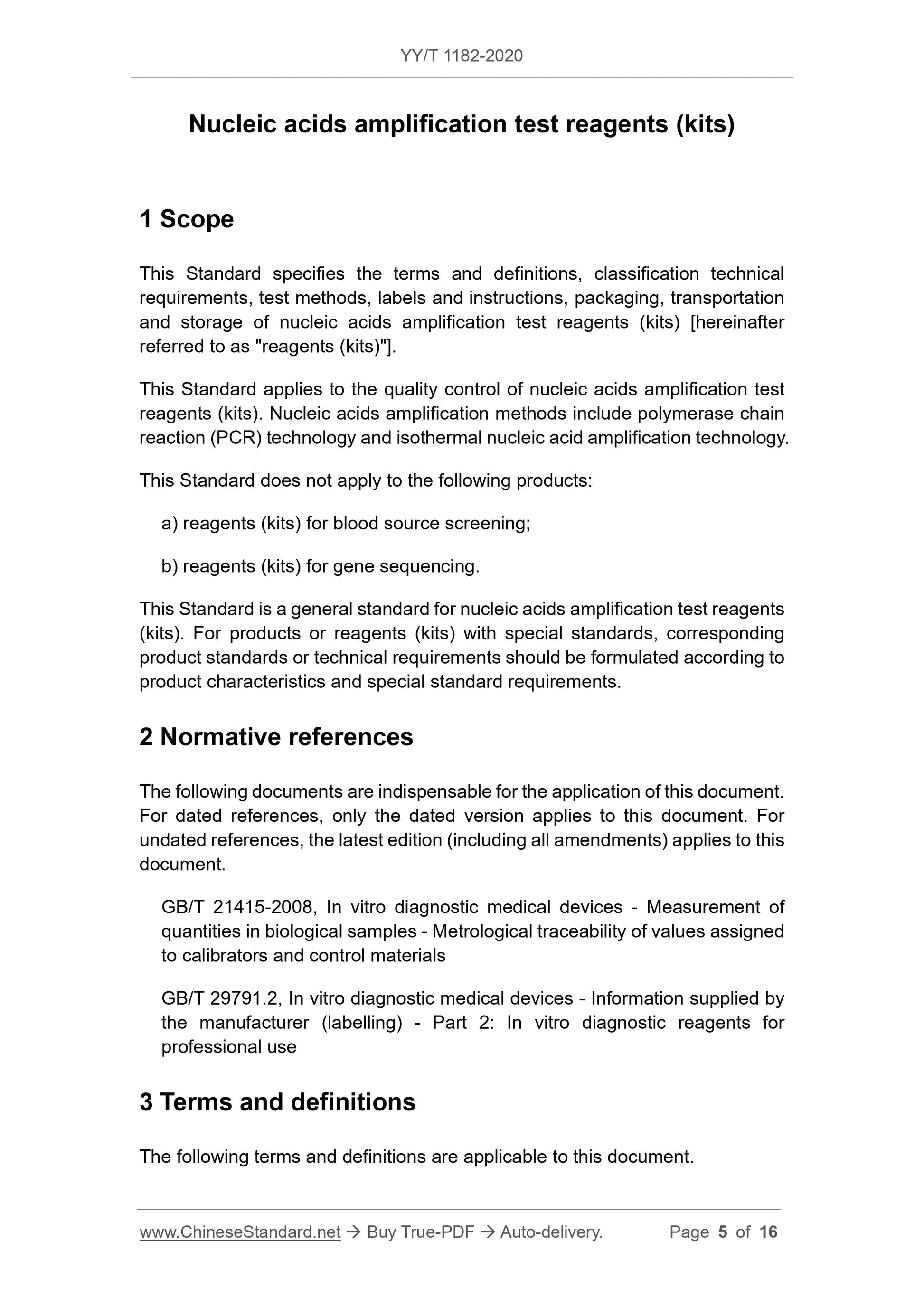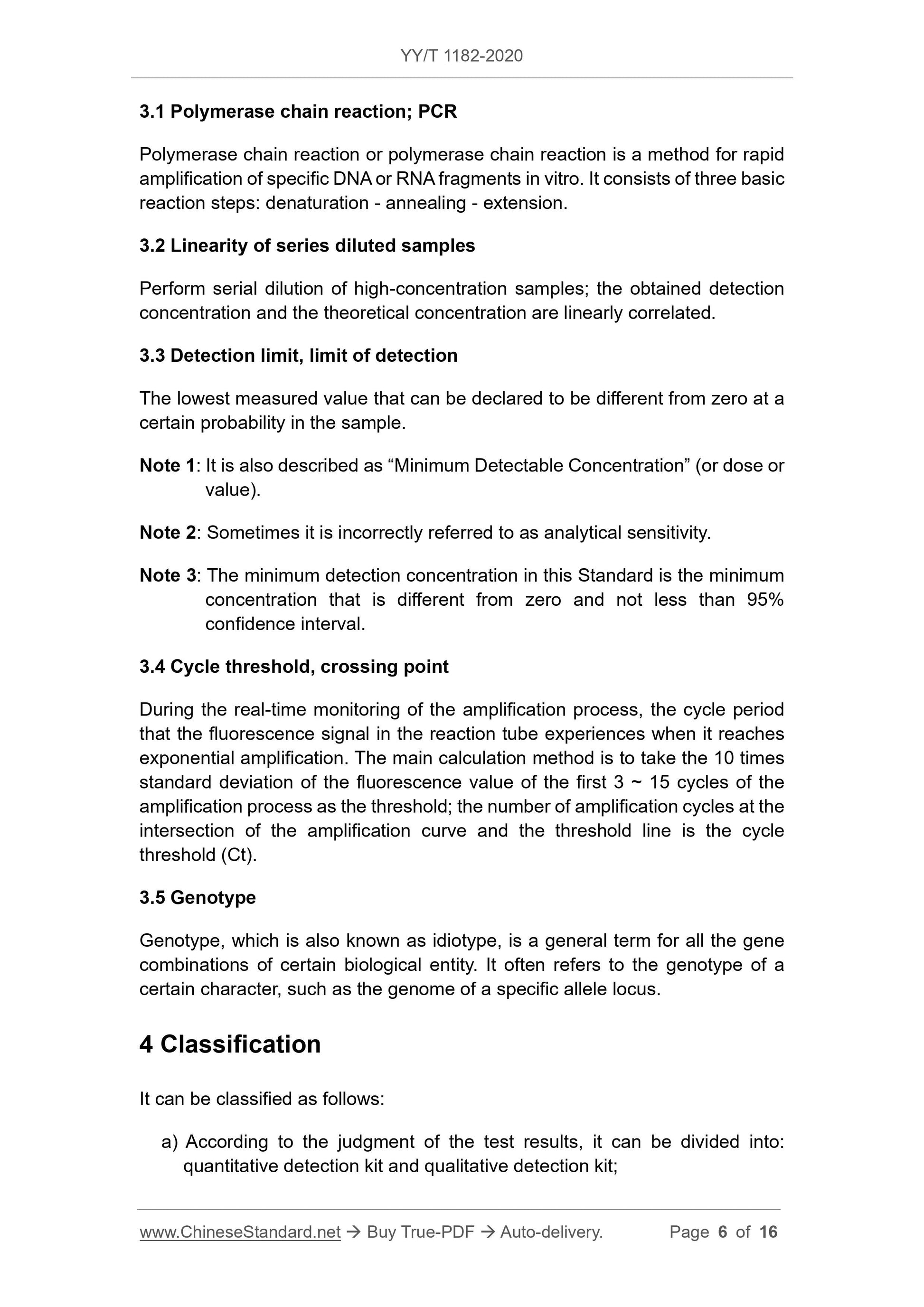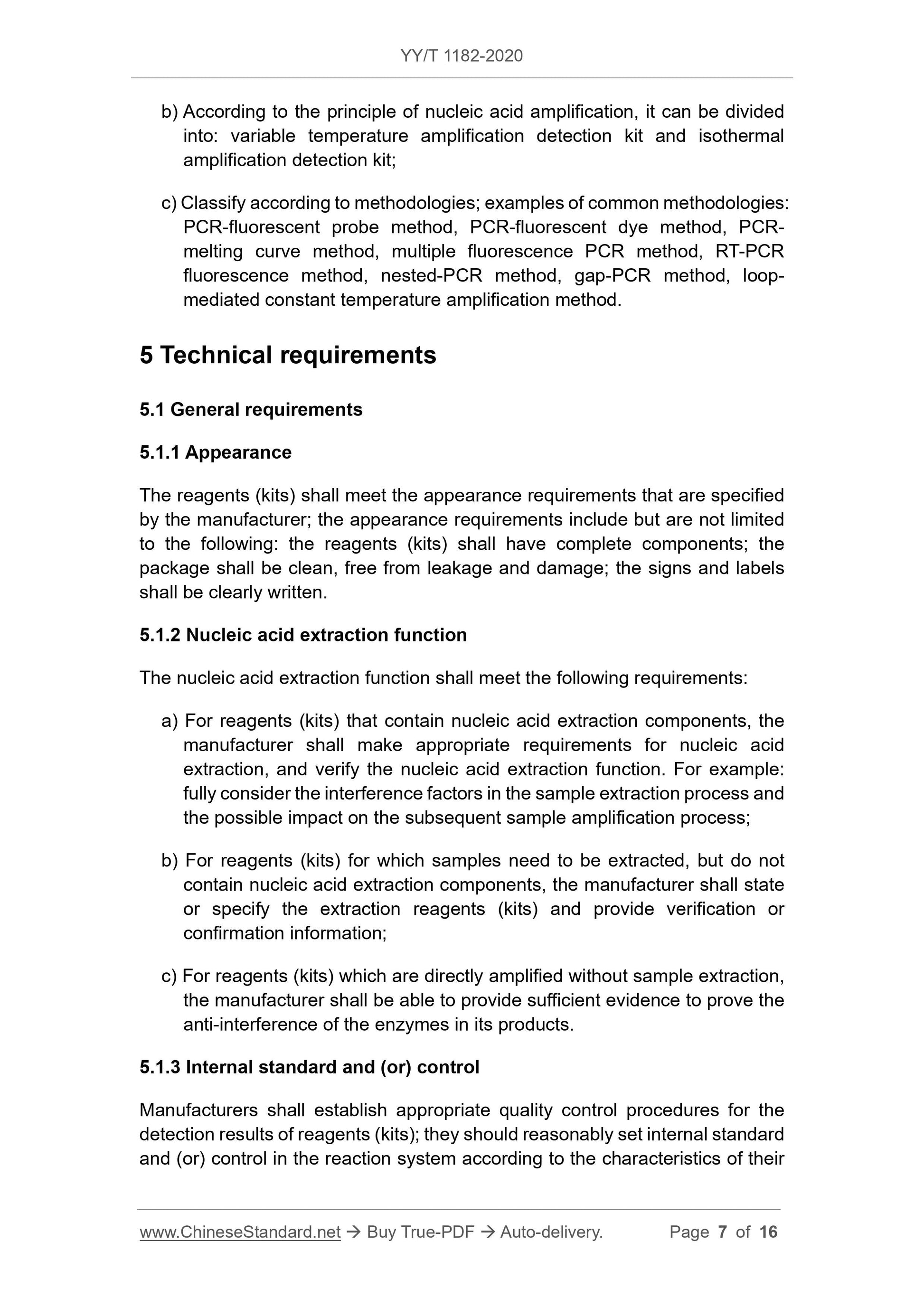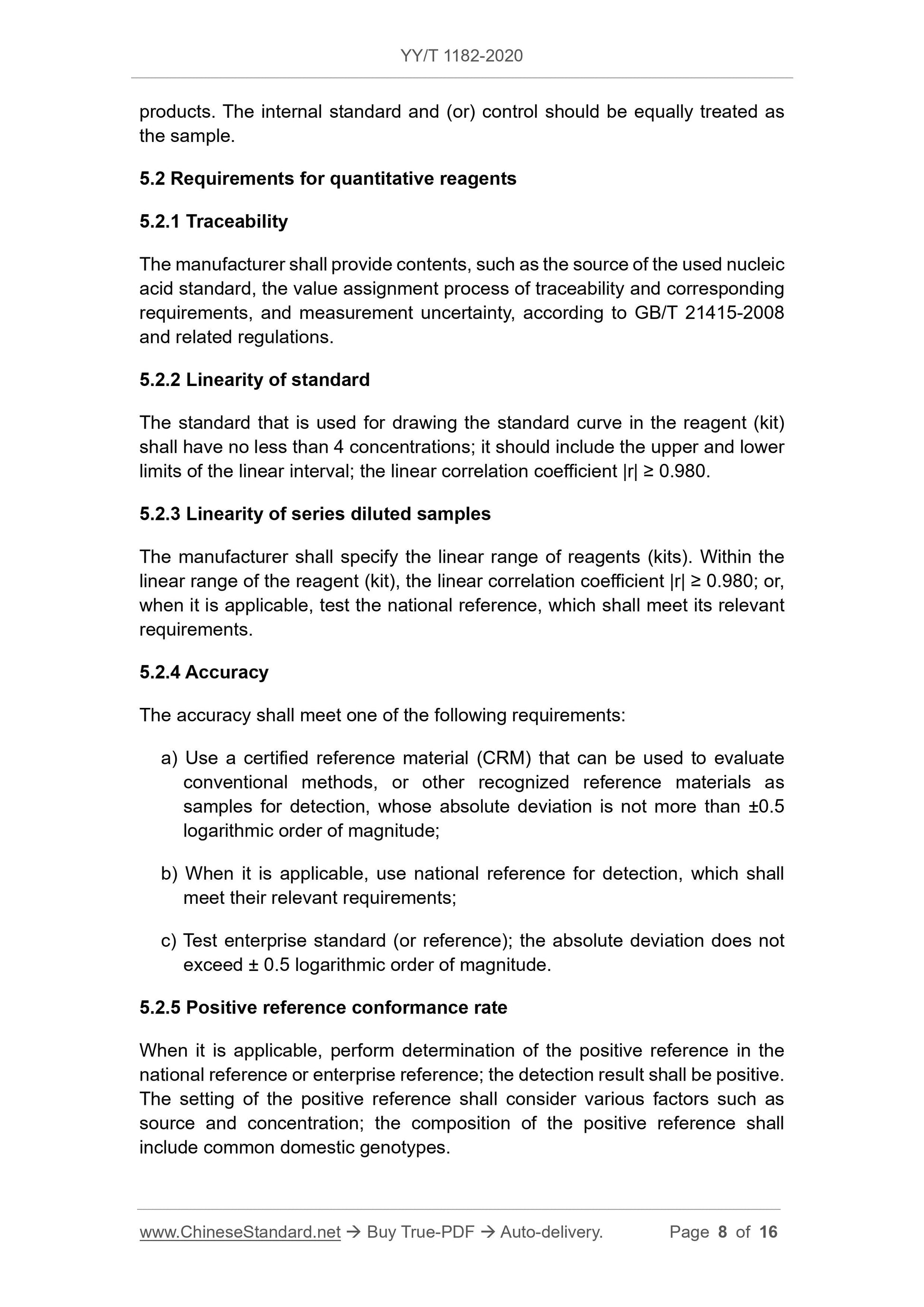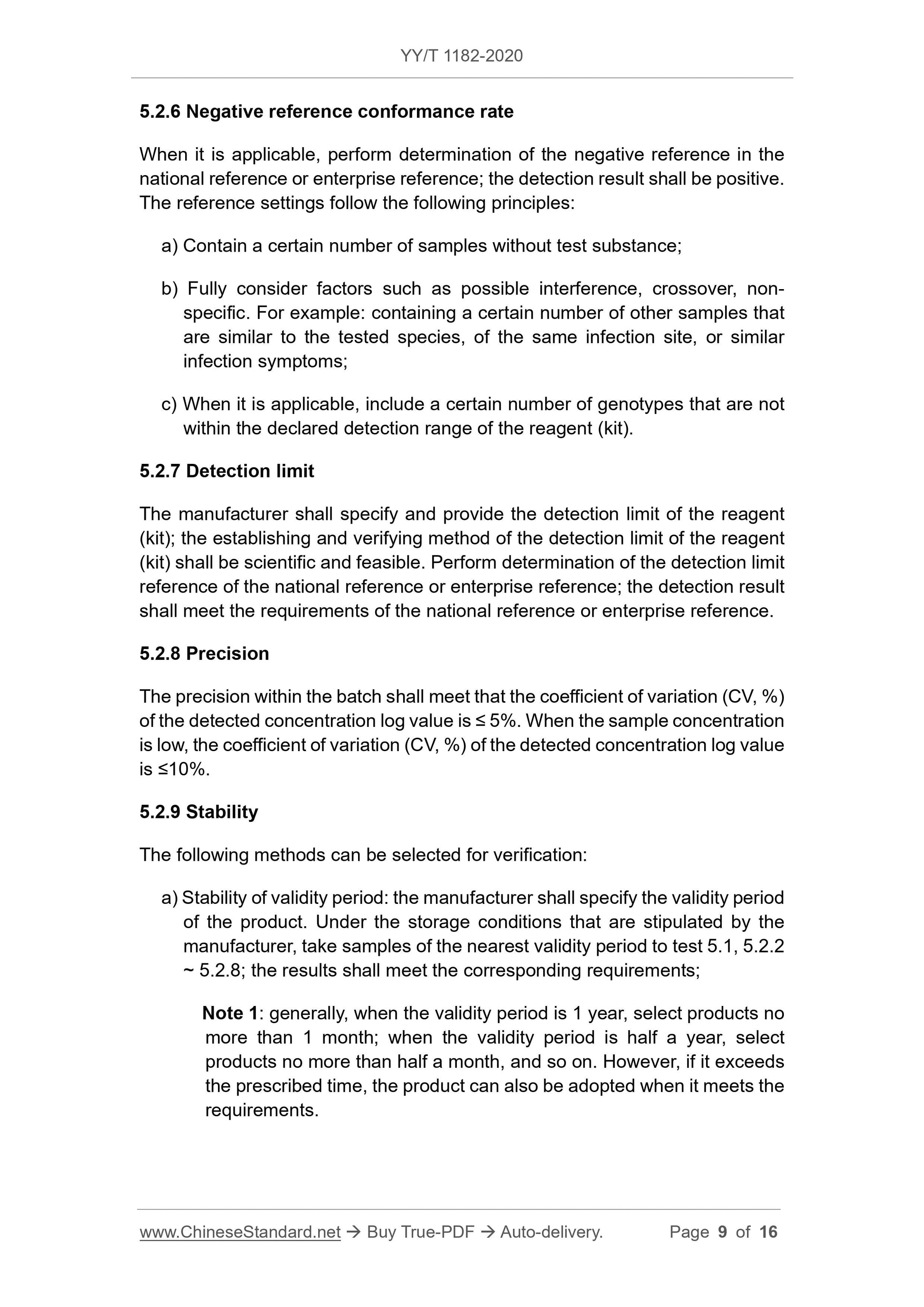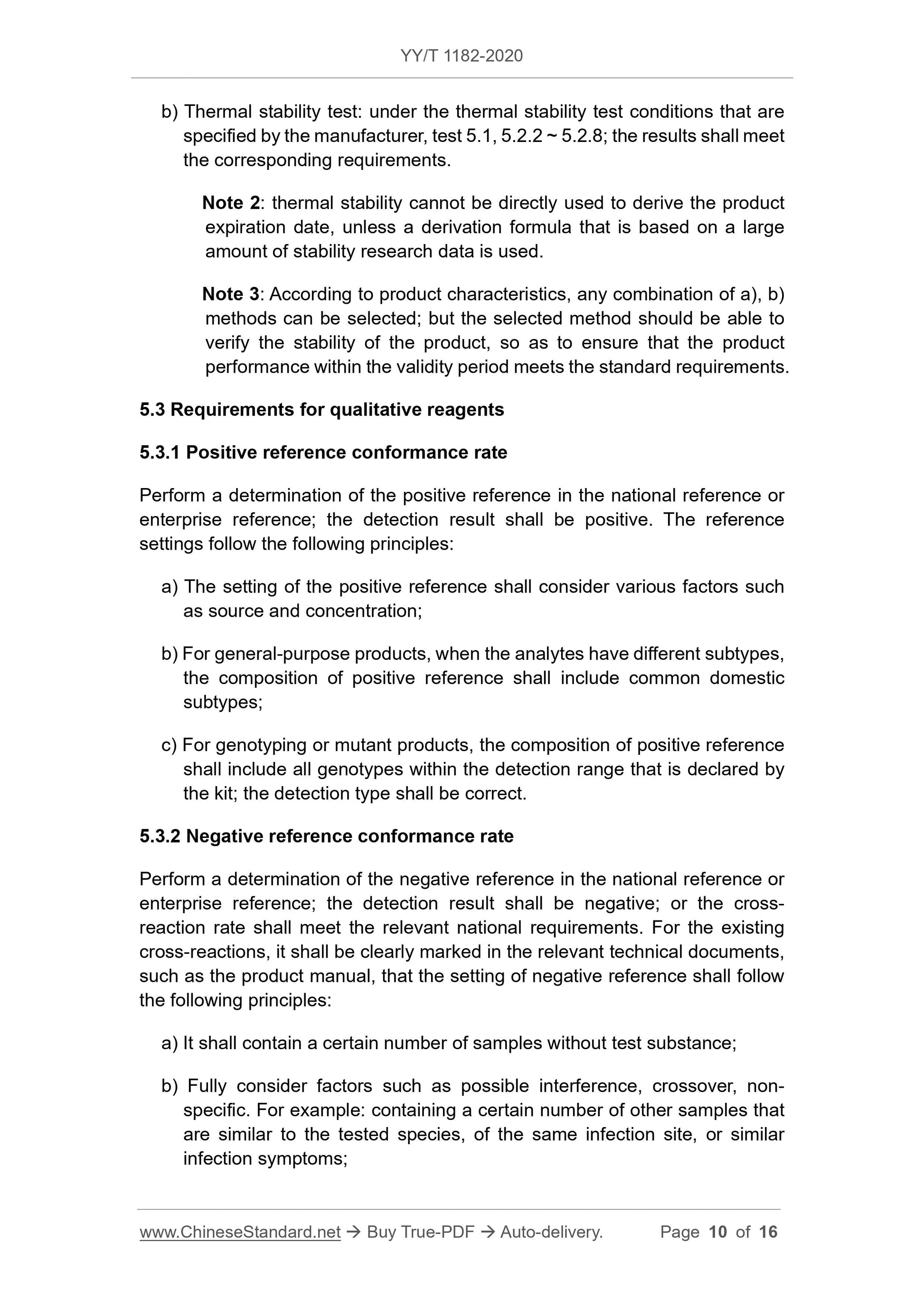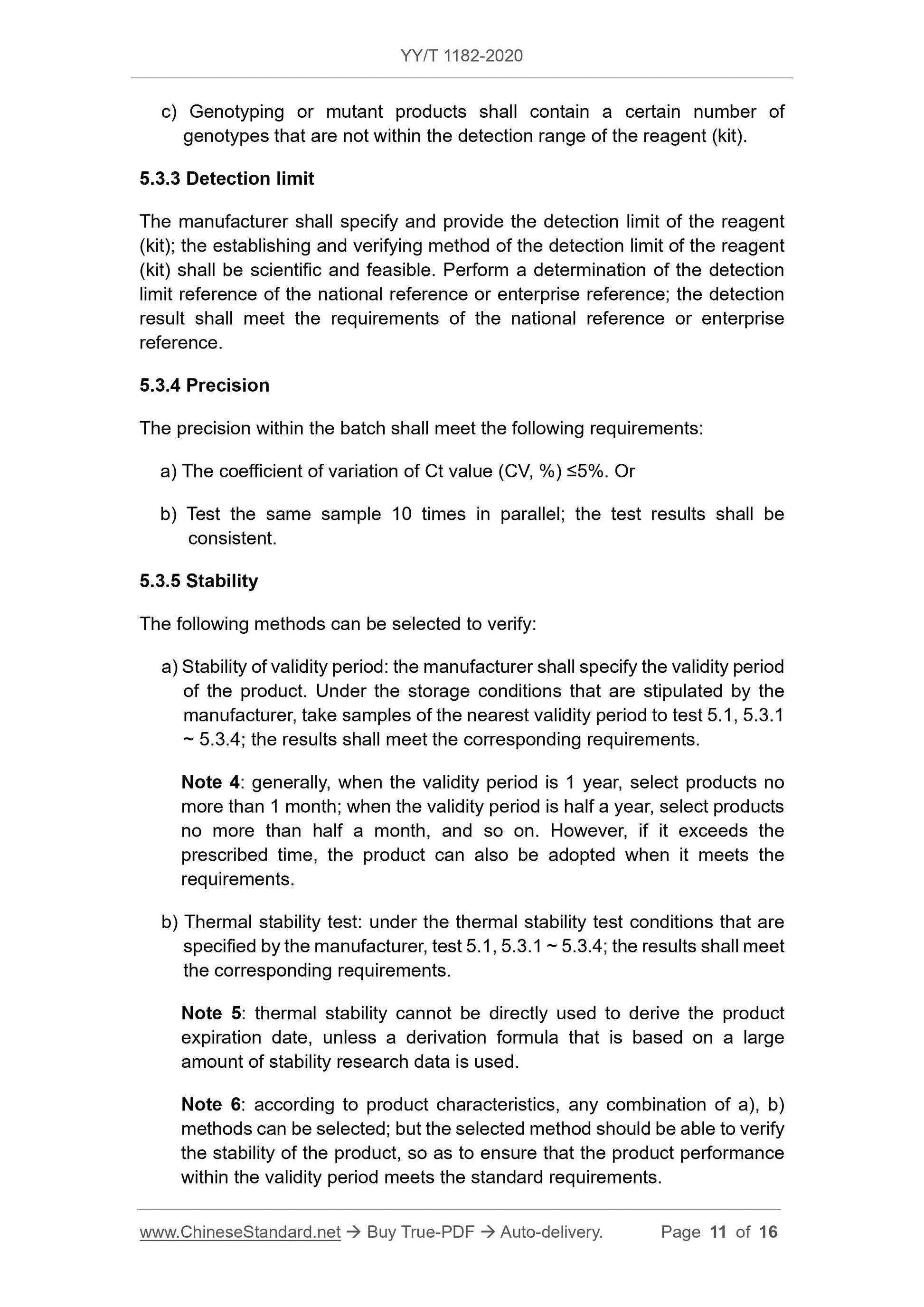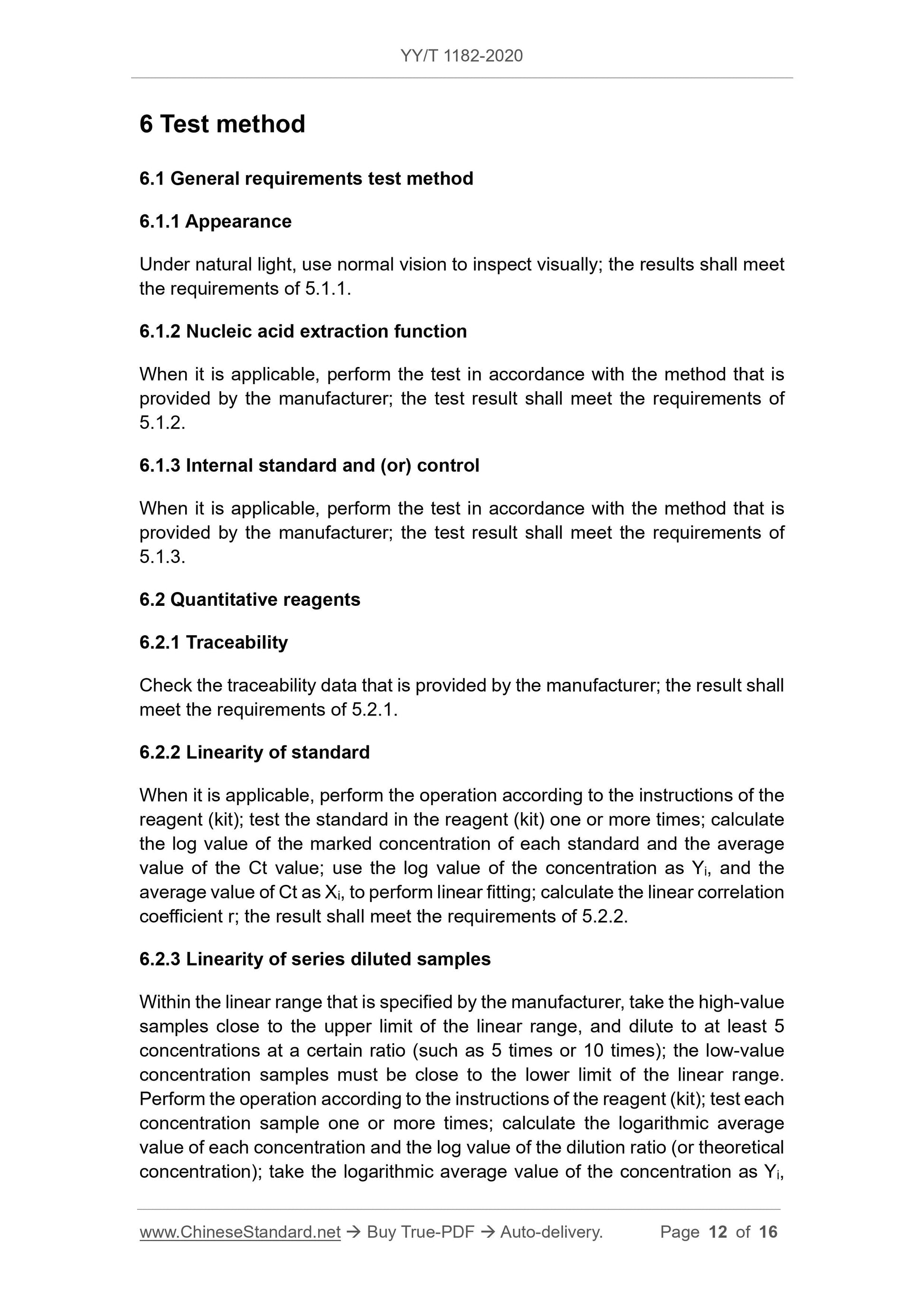1
/
su
12
PayPal, credit cards. Download editable-PDF & invoice in 1 second!
YY/T 1182-2020 English PDF (YYT1182-2020)
YY/T 1182-2020 English PDF (YYT1182-2020)
Prezzo di listino
$165.00 USD
Prezzo di listino
Prezzo scontato
$165.00 USD
Prezzo unitario
/
per
Spese di spedizione calcolate al check-out.
Impossibile caricare la disponibilità di ritiro
Delivery: 3 seconds. Download true-PDF + Invoice.
Get QUOTATION in 1-minute: Click YY/T 1182-2020
Historical versions: YY/T 1182-2020
Preview True-PDF (Reload/Scroll if blank)
YY/T 1182-2020: Nucleic acids amplification test reagents(kits)
YY/T 1182-2020
PHARMACEUTICAL INDUSTRY STANDARD
OF THE PEOPLE’S REPUBLIC OF CHINA
ICS 11.100
C 44
Replacing YY/T 1182-2010
Nucleic acids amplification test reagents (kits)
ISSUED ON: FEBRUARY 21, 2020
IMPLEMENTED ON: JANUARY 01, 2021
Issued by: National Medical Products Administration
Table of Contents
Foreword ... 3
1 Scope ... 5
2 Normative references ... 5
3 Terms and definitions ... 5
4 Classification ... 6
5 Technical requirements ... 7
6 Test method ... 12
7 Labels and instructions ... 15
8 Packaging, transportation and storage ... 15
References ... 16
Nucleic acids amplification test reagents (kits)
1 Scope
This Standard specifies the terms and definitions, classification technical
requirements, test methods, labels and instructions, packaging, transportation
and storage of nucleic acids amplification test reagents (kits) [hereinafter
referred to as "reagents (kits)"].
This Standard applies to the quality control of nucleic acids amplification test
reagents (kits). Nucleic acids amplification methods include polymerase chain
reaction (PCR) technology and isothermal nucleic acid amplification technology.
This Standard does not apply to the following products:
a) reagents (kits) for blood source screening;
b) reagents (kits) for gene sequencing.
This Standard is a general standard for nucleic acids amplification test reagents
(kits). For products or reagents (kits) with special standards, corresponding
product standards or technical requirements should be formulated according to
product characteristics and special standard requirements.
2 Normative references
The following documents are indispensable for the application of this document.
For dated references, only the dated version applies to this document. For
undated references, the latest edition (including all amendments) applies to this
document.
GB/T 21415-2008, In vitro diagnostic medical devices - Measurement of
quantities in biological samples - Metrological traceability of values assigned
to calibrators and control materials
GB/T 29791.2, In vitro diagnostic medical devices - Information supplied by
the manufacturer (labelling) - Part 2: In vitro diagnostic reagents for
professional use
3 Terms and definitions
The following terms and definitions are applicable to this document.
b) According to the principle of nucleic acid amplification, it can be divided
into: variable temperature amplification detection kit and isothermal
amplification detection kit;
c) Classify according to methodologies; examples of common methodologies:
PCR-fluorescent probe method, PCR-fluorescent dye method, PCR-
melting curve method, multiple fluorescence PCR method, RT-PCR
fluorescence method, nested-PCR method, gap-PCR method, loop-
mediated constant temperature amplification method.
5 Technical requirements
5.1 General requirements
5.1.1 Appearance
The reagents (kits) shall meet the appearance requirements that are specified
by the manufacturer; the appearance requirements include but are not limited
to the following: the reagents (kits) shall have complete components; the
package shall be clean, free from leakage and damage; the signs and labels
shall be clearly written.
5.1.2 Nucleic acid extraction function
The nucleic acid extraction function shall meet the following requirements:
a) For reagents (kits) that contain nucleic acid extraction components, the
manufacturer shall make appropriate requirements for nucleic acid
extraction, and verify the nucleic acid extraction function. For example:
fully consider the interference factors in the sample extraction process and
the possible impact on the subsequent sample amplification process;
b) For reagents (kits) for which samples need to be extracted, but do not
contain nucleic acid extraction components, the manufacturer shall state
or specify the extraction reagents (kits) and provide verification or
confirmation information;
c) For reagents (kits) which are directly amplified without sample extraction,
the manufacturer shall be able to provide sufficient evidence to prove the
anti-interference of the enzymes in its products.
5.1.3 Internal standard and (or) control
Manufacturers shall establish appropriate quality control procedures for the
detection results of reagents (kits); they should reasonably set internal standard
and (or) control in the reaction system according to the characteristics of their
5.2.6 Negative reference conformance rate
When it is applicable, perform determination of the negative reference in the
national reference or enterprise reference; the detection result shall be positive.
The reference settings follow the following principles:
a) Contain a certain number of samples without test substance;
b) Fully consider factors such as possible interference, crossover, non-
specific. For example: containing a certain number of other samples that
are similar to the tested species, of the same infection site, or similar
infection symptoms;
c) When it is applicable, include a certain number of genotypes that are not
within the declared detection range of the reagent (kit).
5.2.7 Detection limit
The manufacturer shall specify and provide the detection limit of the reagent
(kit); the establishing and verifying method of the detection limit of the reagent
(kit) shall be scientific and feasible. Perform determination of the detection limit
reference of the national reference or enterprise reference; the detection result
shall meet the requirements of the national reference or enterprise reference.
5.2.8 Precision
The precision within the batch shall meet that the coefficient of variation (CV, %)
of the detected concentration log value is ≤ 5%. When the sample concentration
is low, the coefficient of variation (CV, %) of the detected concentration log value
is ≤10%.
5.2.9 Stability
The following methods can be selected for verification:
a) Stability of validity period: the manufacturer shall specify the validity period
of the product. Under the storage conditions that are stipulated by the
manufacturer, take samples of the nearest validity period to test 5.1, 5.2.2
~ 5.2.8; the results shall meet the corresponding requirements;
Note 1: generally, when the validity period is 1 year, select products no
more than 1 month; when the validity period is half a year, select
products no more than half a month, and so on. However, if it exceeds
the prescribed time, the product can also be adopted when it meets the
requirements.
c) Genotyping or mutant products shall contain a certain number of
genotypes that are not within the detection range of the reagent (kit).
5.3.3 Detection limit
The manufacturer shall specify and provide the detection limit of the reagent
(kit); the establishing and verifying method of the detection limit of the reagent
(kit) shall be scientific and feasible. Perform a determination of the detection
limit reference of the national reference or enterprise reference; the detection
result shall meet the requirements of the national reference or enterprise
reference.
5.3.4 Precision
The precision within the batch shall meet the following requirements:
a) The coefficient of variation of Ct value (CV, %) ≤5%. Or
b) Test the same sample 10 times in parallel; the test results shall be
consistent.
5.3.5 Stability
The following methods can be selected to verify:
a) Stability of v...
Get QUOTATION in 1-minute: Click YY/T 1182-2020
Historical versions: YY/T 1182-2020
Preview True-PDF (Reload/Scroll if blank)
YY/T 1182-2020: Nucleic acids amplification test reagents(kits)
YY/T 1182-2020
PHARMACEUTICAL INDUSTRY STANDARD
OF THE PEOPLE’S REPUBLIC OF CHINA
ICS 11.100
C 44
Replacing YY/T 1182-2010
Nucleic acids amplification test reagents (kits)
ISSUED ON: FEBRUARY 21, 2020
IMPLEMENTED ON: JANUARY 01, 2021
Issued by: National Medical Products Administration
Table of Contents
Foreword ... 3
1 Scope ... 5
2 Normative references ... 5
3 Terms and definitions ... 5
4 Classification ... 6
5 Technical requirements ... 7
6 Test method ... 12
7 Labels and instructions ... 15
8 Packaging, transportation and storage ... 15
References ... 16
Nucleic acids amplification test reagents (kits)
1 Scope
This Standard specifies the terms and definitions, classification technical
requirements, test methods, labels and instructions, packaging, transportation
and storage of nucleic acids amplification test reagents (kits) [hereinafter
referred to as "reagents (kits)"].
This Standard applies to the quality control of nucleic acids amplification test
reagents (kits). Nucleic acids amplification methods include polymerase chain
reaction (PCR) technology and isothermal nucleic acid amplification technology.
This Standard does not apply to the following products:
a) reagents (kits) for blood source screening;
b) reagents (kits) for gene sequencing.
This Standard is a general standard for nucleic acids amplification test reagents
(kits). For products or reagents (kits) with special standards, corresponding
product standards or technical requirements should be formulated according to
product characteristics and special standard requirements.
2 Normative references
The following documents are indispensable for the application of this document.
For dated references, only the dated version applies to this document. For
undated references, the latest edition (including all amendments) applies to this
document.
GB/T 21415-2008, In vitro diagnostic medical devices - Measurement of
quantities in biological samples - Metrological traceability of values assigned
to calibrators and control materials
GB/T 29791.2, In vitro diagnostic medical devices - Information supplied by
the manufacturer (labelling) - Part 2: In vitro diagnostic reagents for
professional use
3 Terms and definitions
The following terms and definitions are applicable to this document.
b) According to the principle of nucleic acid amplification, it can be divided
into: variable temperature amplification detection kit and isothermal
amplification detection kit;
c) Classify according to methodologies; examples of common methodologies:
PCR-fluorescent probe method, PCR-fluorescent dye method, PCR-
melting curve method, multiple fluorescence PCR method, RT-PCR
fluorescence method, nested-PCR method, gap-PCR method, loop-
mediated constant temperature amplification method.
5 Technical requirements
5.1 General requirements
5.1.1 Appearance
The reagents (kits) shall meet the appearance requirements that are specified
by the manufacturer; the appearance requirements include but are not limited
to the following: the reagents (kits) shall have complete components; the
package shall be clean, free from leakage and damage; the signs and labels
shall be clearly written.
5.1.2 Nucleic acid extraction function
The nucleic acid extraction function shall meet the following requirements:
a) For reagents (kits) that contain nucleic acid extraction components, the
manufacturer shall make appropriate requirements for nucleic acid
extraction, and verify the nucleic acid extraction function. For example:
fully consider the interference factors in the sample extraction process and
the possible impact on the subsequent sample amplification process;
b) For reagents (kits) for which samples need to be extracted, but do not
contain nucleic acid extraction components, the manufacturer shall state
or specify the extraction reagents (kits) and provide verification or
confirmation information;
c) For reagents (kits) which are directly amplified without sample extraction,
the manufacturer shall be able to provide sufficient evidence to prove the
anti-interference of the enzymes in its products.
5.1.3 Internal standard and (or) control
Manufacturers shall establish appropriate quality control procedures for the
detection results of reagents (kits); they should reasonably set internal standard
and (or) control in the reaction system according to the characteristics of their
5.2.6 Negative reference conformance rate
When it is applicable, perform determination of the negative reference in the
national reference or enterprise reference; the detection result shall be positive.
The reference settings follow the following principles:
a) Contain a certain number of samples without test substance;
b) Fully consider factors such as possible interference, crossover, non-
specific. For example: containing a certain number of other samples that
are similar to the tested species, of the same infection site, or similar
infection symptoms;
c) When it is applicable, include a certain number of genotypes that are not
within the declared detection range of the reagent (kit).
5.2.7 Detection limit
The manufacturer shall specify and provide the detection limit of the reagent
(kit); the establishing and verifying method of the detection limit of the reagent
(kit) shall be scientific and feasible. Perform determination of the detection limit
reference of the national reference or enterprise reference; the detection result
shall meet the requirements of the national reference or enterprise reference.
5.2.8 Precision
The precision within the batch shall meet that the coefficient of variation (CV, %)
of the detected concentration log value is ≤ 5%. When the sample concentration
is low, the coefficient of variation (CV, %) of the detected concentration log value
is ≤10%.
5.2.9 Stability
The following methods can be selected for verification:
a) Stability of validity period: the manufacturer shall specify the validity period
of the product. Under the storage conditions that are stipulated by the
manufacturer, take samples of the nearest validity period to test 5.1, 5.2.2
~ 5.2.8; the results shall meet the corresponding requirements;
Note 1: generally, when the validity period is 1 year, select products no
more than 1 month; when the validity period is half a year, select
products no more than half a month, and so on. However, if it exceeds
the prescribed time, the product can also be adopted when it meets the
requirements.
c) Genotyping or mutant products shall contain a certain number of
genotypes that are not within the detection range of the reagent (kit).
5.3.3 Detection limit
The manufacturer shall specify and provide the detection limit of the reagent
(kit); the establishing and verifying method of the detection limit of the reagent
(kit) shall be scientific and feasible. Perform a determination of the detection
limit reference of the national reference or enterprise reference; the detection
result shall meet the requirements of the national reference or enterprise
reference.
5.3.4 Precision
The precision within the batch shall meet the following requirements:
a) The coefficient of variation of Ct value (CV, %) ≤5%. Or
b) Test the same sample 10 times in parallel; the test results shall be
consistent.
5.3.5 Stability
The following methods can be selected to verify:
a) Stability of v...
Share
